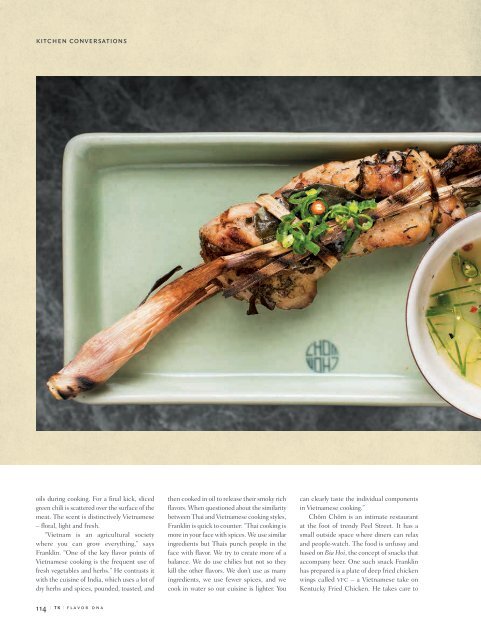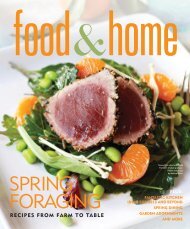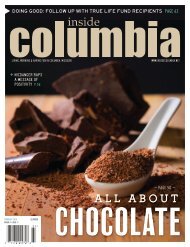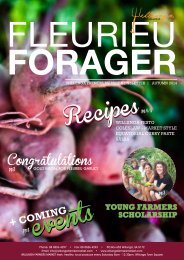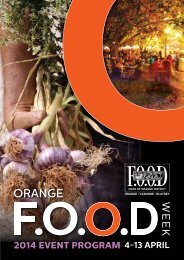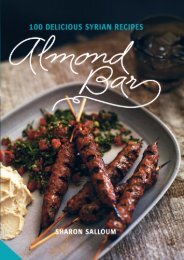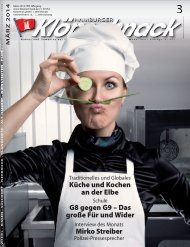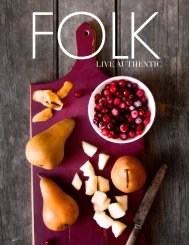Tasting Kitchen
Welcome to Tasting Kitchen. Season’s Greetings – or should I say Seasonings Greetings! This holiday TK issue is full of spices and flavorings. We talk to four talented and ambitious chefs about the flavor profile – or Flavor DNA – of dishes from India, Sichuan, Vietnam and the Isaan region of Thailand. Think cardamom, black salt and saffron, red peppercorns, red chilies and green chilies, dill, Kaffir lime, lemongrass, coriander, galangal and turmeric. We take a look at spices in history, and how even back in the Middle Ages savvy marketers knew the value of a good story. Spice merchants claimed that birds used cinnamon sticks to make giant nests in the cliffs above beaches in India, which “cinnamon hunters” then plotted to obtain. Today India is still associated with the world’s best spices. In this issue, for our first Tasting Destinations feature, TK’s Director of Photography David Hartung and Senior Writer Lucy Morgan traveled to Old Delhi to visit the world’s largest spice market and to New Delhi to visit one of the world’s top restaurants for modern Indian cuisine. One of our featured wines is the peppery Austrian Grüner Veltliner. We also talk to a New Zealand Wine Master about what makes great wine great, and to a leading French Champagne Chef de Cave about the value of patience and restraint. There are also some crabs running loose in the issue. A master chef in Macau shares his recipe for Quinoa Lobster Salad while five more from Hong Kong and Singapore share their favorite crab dishes and culinary musings. Happy Holidays,
Welcome to Tasting Kitchen.
Season’s Greetings – or should I say
Seasonings Greetings!
This holiday TK issue is full of spices and
flavorings.
We talk to four talented and ambitious
chefs about the flavor profile – or Flavor DNA
– of dishes from India, Sichuan, Vietnam and
the Isaan region of Thailand. Think cardamom,
black salt and saffron, red peppercorns, red
chilies and green chilies, dill, Kaffir lime,
lemongrass, coriander, galangal and turmeric.
We take a look at spices in history, and
how even back in the Middle Ages savvy marketers knew the value of a good story.
Spice merchants claimed that birds used cinnamon sticks to make giant nests in the
cliffs above beaches in India, which “cinnamon hunters” then plotted to obtain.
Today India is still associated with the world’s best spices. In this issue, for
our first Tasting Destinations feature, TK’s Director of Photography David Hartung
and Senior Writer Lucy Morgan traveled to Old Delhi to visit the world’s largest
spice market and to New Delhi to visit one of the world’s top restaurants for modern
Indian cuisine.
One of our featured wines is the peppery Austrian Grüner Veltliner. We also
talk to a New Zealand Wine Master about what makes great wine great, and to a
leading French Champagne Chef de Cave about the value of patience and restraint.
There are also some crabs running loose in the issue. A master chef in Macau
shares his recipe for Quinoa Lobster Salad while five more from Hong Kong and
Singapore share their favorite crab dishes and culinary musings.
Happy Holidays,
You also want an ePaper? Increase the reach of your titles
YUMPU automatically turns print PDFs into web optimized ePapers that Google loves.
kitchen conversations<br />
oils during cooking. For a final kick, sliced<br />
green chili is scattered over the surface of the<br />
meat. The scent is distinctively Vietnamese<br />
– floral, light and fresh.<br />
“Vietnam is an agricultural society<br />
where you can grow everything,” says<br />
Franklin. “One of the key flavor points of<br />
Vietnamese cooking is the frequent use of<br />
fresh vegetables and herbs.” He contrasts it<br />
with the cuisine of India, which uses a lot of<br />
dry herbs and spices, pounded, toasted, and<br />
114<br />
| TK | flavor dna<br />
then cooked in oil to release their smoky rich<br />
flavors. When questioned about the similarity<br />
between Thai and Vietnamese cooking styles,<br />
Franklin is quick to counter: “Thai cooking is<br />
more in your face with spices. We use similar<br />
ingredients but Thais punch people in the<br />
face with flavor. We try to create more of a<br />
balance. We do use chilies but not so they<br />
kill the other flavors. We don’t use as many<br />
ingredients, we use fewer spices, and we<br />
cook in water so our cuisine is lighter. You<br />
can clearly taste the individual components<br />
in Vietnamese cooking.”<br />
Chôm Chôm is an intimate restaurant<br />
at the foot of trendy Peel Street. It has a<br />
small outside space where diners can relax<br />
and people-watch. The food is unfussy and<br />
based on Bia Hoi, the concept of snacks that<br />
accompany beer. One such snack Franklin<br />
has prepared is a plate of deep fried chicken<br />
wings called VFC – a Vietnamese take on<br />
Kentucky Fried Chicken. He takes care to


